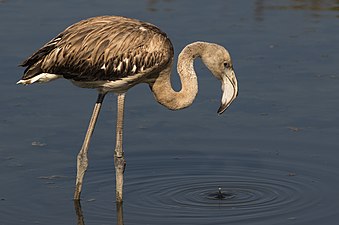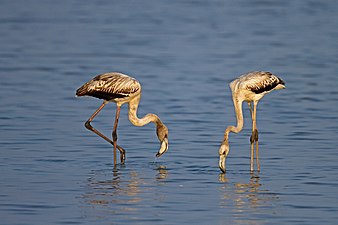Is 2/7 Greater Than 2/5
| Greater flamingo | |
|---|---|
 | |
| in Bahrain Voice of the greater flamingo | |
| Conservation condition | |
| | |
| CITES Appendix II (CITES)[2] | |
| Scientific nomenclature | |
| Kingdom: | Animalia |
| Phylum: | Chordata |
| Grade: | Aves |
| Order: | Phoenicopteriformes |
| Family: | Phoenicopteridae |
| Genus: | Phoenicopterus |
| Species: | P. roseus |
| Binomial proper name | |
| Phoenicopterus roseus Pallas, 1811 | |
| Synonyms | |
| |
The greater flamingo ( Phoenicopterus roseus ) is the most widespread and largest species of the flamingo family. It is found in Africa, the Indian subcontinent, the Middle East, and in southern Europe.
Taxonomy [edit]
The greater flamingo was described by Peter Simon Pallas in 1811. It was previously thought to be the same species equally the American flamingo (Phoenicopterus ruber), only because of coloring differences of its head, cervix, body, and pecker, the two flamingos are now virtually commonly considered carve up species. The greater flamingo has no subspecies.[4]
Clarification [edit]
The greater flamingo is the largest living species of flamingo,[5] averaging 110–150 cm (43–59 in) tall and weighing 2–4 kg (4.4–viii.8 lb). The largest male flamingos have been recorded at up to 187 cm (74 in) tall and 4.5 kg (9.nine lb).[six]
Most of the feather is pinkish-white, but the wing coverts are red and the primary and secondary flight feathers are black. The bill is pink with a restricted blackness tip, and the legs are entirely pink. The call is a goose-like honking.
Chicks are covered in gray fluffy down. Subadult flamingos are paler with night legs. Adults feeding chicks also become paler, but retain the bright pink legs. The coloration comes from the carotenoid pigments in the organisms that live in their feeding grounds. Secretions of the uropygial gland also contain carotenoids. During the breeding season, greater flamingos increase the frequency of their spreading uropygial secretions over their feathers and thereby enhance their colour. This corrective use of uropygial secretions has been described every bit applying "make-up".[7]
-

-

Chick with gray down
-

Juvenile) at Ghadira Nature Reserve, Malta
-

Subadults at Pulicat Lake, Republic of india
-

Distribution [edit]
It is found in parts of Africa, south asia (People's republic of bangladesh and coastal regions of Pakistan, India, and Sri Lanka), the Center East (Bahrain, Republic of cyprus, Iraq, Iran, Sultanate of oman, Israel, State of kuwait, Lebanon, Qatar, and the United Arab Emirates) and southern Europe (including Albania, Bulgaria, Hellenic republic, Italy, Montenegro, North Republic of macedonia, Portugal, Spain, Turkey, and South of France).[eight] The most northern convenance spot is the Zwillbrocker Venn in western Federal republic of germany, close to the border with the Netherlands. They accept been recorded breeding in the United Arab Emirates at three different locations in the Abu Dhabi Emirate.[9] In Gujarat, a state of India, flamingos tin be observed at the Nal Sarovar Bird Sanctuary, Khijadiya Bird Sanctuary, Flamingo City, and in the Thol Bird Sanctuary. They remain there during the entire winter season.[10]
Environmental [edit]
The greater flamingo resides in mudflats and shallow coastal lagoons with table salt water. Using its feet, the bird stirs up the mud, and so sucks water through its beak and filters out small shrimp, seeds, blue-dark-green algae, microscopic organisms, and mollusks. The greater flamingo feeds with its head downwardly, and its upper jaw is movable and not rigidly fixed to its skull.[11]
Like all flamingos, this type of species lays a single chalky-white egg on a mud mound.
Lifespan [edit]
The typical lifespan in captivity, according to Basel Zoo, is over 60 years.[12] In the wild, the boilerplate lifespan is 30 – 40 years.[thirteen]
Threats and predators [edit]
Natural [edit]
Adult greater flamingos have few natural predators. Eggs and chicks may exist eaten by raptors, crows, gulls, and the marabou stork (Leptoptilos crumenifer); an estimated one-half of the predation of greater flamingo eggs and chicks is from the yellow-legged dupe (Larus michahellis).[14]
Human [edit]
The primary threats to flamingo populations are bacteria, toxins, and pollution in water supplies, which is usually run-off from manufacturing companies, and encroachment on their habitat.
In human captivity [edit]
The showtime recorded zoo hatch was in 1959 at Zoo Basel. In Zoo Basel's breeding plan, over 400 birds have been hatched with between 20 and 27 per year since 2000.[15] The oldest known greater flamingo was a bird at the Adelaide Zoo in Commonwealth of australia that died anile at to the lowest degree 83 years. The bird'southward exact age is not known; he was already a mature adult when he arrived in Adelaide in 1933. He was euthanized in January 2014 due to complications of one-time age.[16] [17]
-

A subadult (top) with an adult (bottom) in flight
-

-
The skeleton of a greater flamingo
-
A subadult feeding in Walvis Bay
References [edit]
- ^ BirdLife International (2019) [amended version of 2018 cess]. "Phoenicopterus roseus". IUCN Cerise List of Threatened Species. 2019. doi:10.2305/IUCN.Britain.2018-ii.RLTS.T22697360A155527405.en . Retrieved 15 February 2022.
- ^ "Appendices | CITES". cites.org . Retrieved 2022-01-14 .
- ^ de Klemm, Cyrille; Lausche, Barbara J. (1987). African Wild fauna Laws. IUCN. p. 1147. ISBN2880320917 . Retrieved 23 March 2019.
- ^ del Hoyo, J.; Collar, N.; Garcia, E. F. J. (2020). Del Hoyo, Josep; Elliott, Andrew; Sargatal, Jordi; Christie, David; De Juana, Eduardo (eds.). "Greater Flamingo (Phoenicopterus roseus)". Handbook of the Birds of the World Alive. Barcelona, Espana: Lynx Edicions. doi:10.2173/bow.grefla3.01. S2CID 241655366. Retrieved 23 March 2019.
- ^ Feduccia, Alan (1999). The Origin and Evolution of Birds (illustrated, reprint ed.). Yale Academy Press. p. 196. ISBN0300078617 . Retrieved 23 March 2019.
- ^ "Greater flamingo" (PDF). Archived from the original (PDF) on 2009-02-26. Retrieved 2008-10-xxx .
- ^ Amat, J.A.; Rendón, M.A.; Garrido-Fernández, J.; Garrido, A.; Rendón-Martos, M. & Pérez-Gálvez, A. (2011). "Greater flamingos Phoenicopterus roseus utilise uropygial secretions as make-up". Behavioral Ecology and Sociobiology. 65 (4): 665–673. doi:ten.1007/s00265-010-1068-z. S2CID 30299643.
- ^ "Phoenicopterus roseus". Global Biodiversity Information Facility.
- ^ Khan, Shahid; et al. (2017). "Greater Flamingo (Phoenicopterus roseus): Important wintering sites and breeding records in the United Arab Emirates". Zoology in the Heart East. 63 (3): 194–201. doi:10.1080/09397140.2017.1331586. S2CID 90286615.
- ^ Koshti A.J. and Bony L.S (2016). "Ethology of greater flamingo in captivity", Undergraduate thesis submitted to St.Xavier's College, Ahmedabad, Republic of india.
- ^ "Flamingo Feeding". Stanford University . Retrieved eleven March 2013.
- ^ "Animals-Vögel-Flamingo". Basel Zoo . Retrieved 23 March 2019.
- ^ "Greater Flamingo - Facts, Diet & Habitat Information".
- ^ "Greater flamingo (Phoenicopterus roseus)". Marwell Zoo . Retrieved 23 March 2019.
- ^ "Zolli feiert 50 Jahre Flamingozucht und Flamingosforschung" [50 years of flamingo breeding]. Basler Zeitung (in German). xiii August 2008. Archived from the original on March 22, 2009.
- ^ Kelton, Sam (31 January 2014). "Greater, the 83-year-old Adelaide Zoo flamingo, dies". The Advertiser . Retrieved 31 January 2014.
- ^ Fedorowytsch, Tom (31 Jan 2014). "Flamingo believed to be world's oldest dies at Adelaide Zoo aged 83". ABC News . Retrieved 31 January 2014.
External links [edit]
- Performing greater flamingos in open field Archived 2018-01-09 at the Wayback Motorcar
- Greater flamingo - Species text - The Atlas of Southern African Birds
- Article with video about Greater Flamingo at avibirds.com
Is 2/7 Greater Than 2/5,
Source: https://en.wikipedia.org/wiki/Greater_flamingo
Posted by: lohmanmrsed2001.blogspot.com




0 Response to "Is 2/7 Greater Than 2/5"
Post a Comment